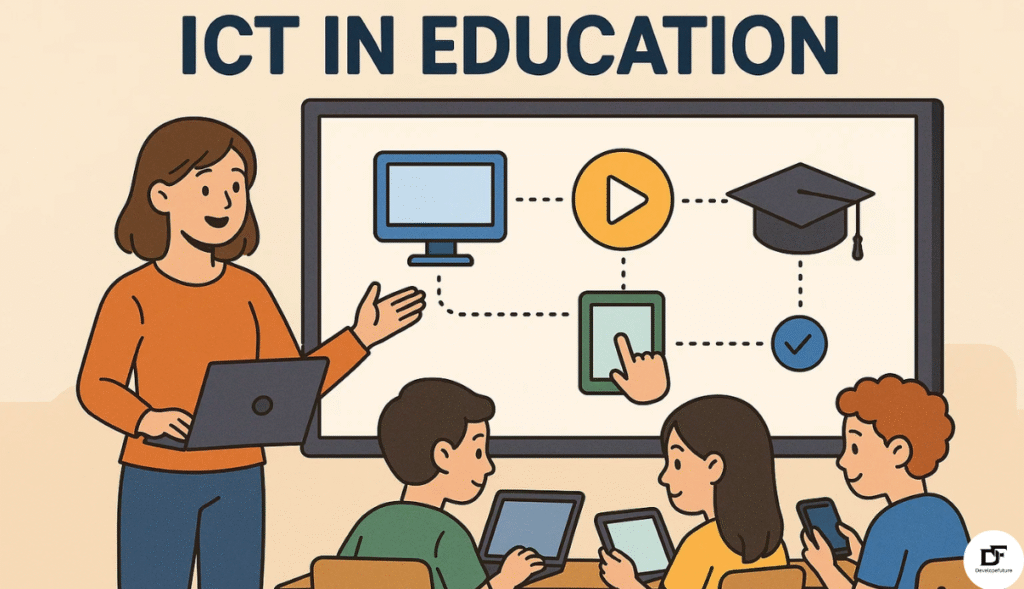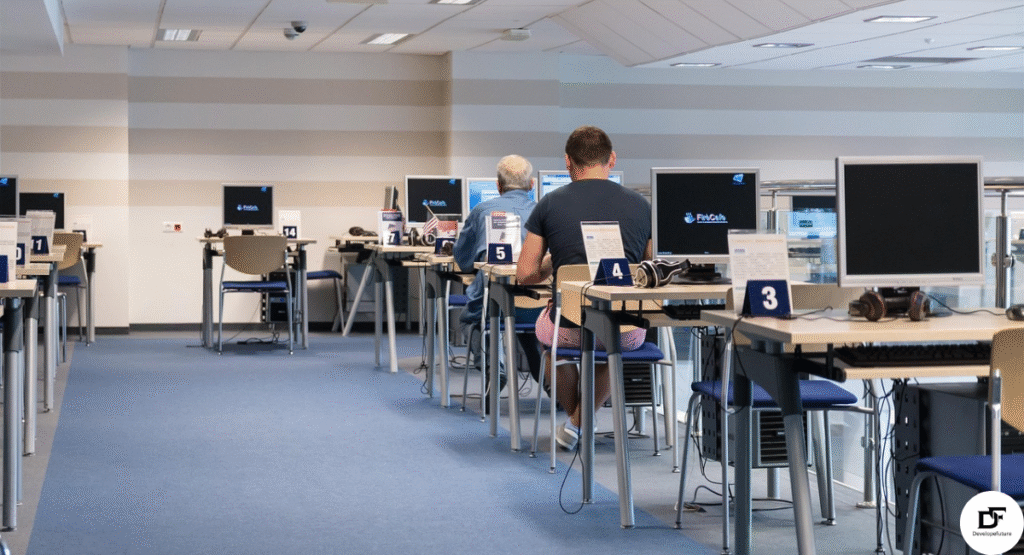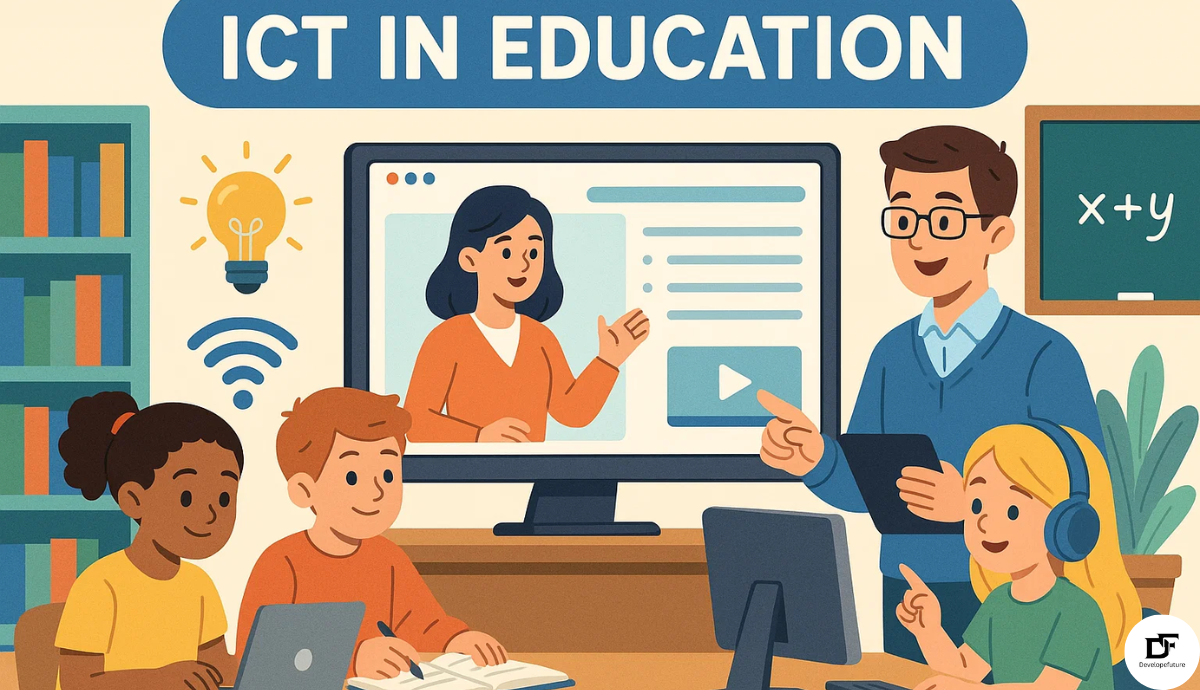In today’s world, Information and Communication Technology (ICT) has become a key part of education. From primary schools to universities, ICT in Education is changing how students learn. Also, how teachers teach, and how administrators manage systems. This shift reflects the growing role of digital tools in daily life. And the demands of a fast-moving global economy. Since education is the backbone of society. ICT is now essential to prepare learners for the challenges of the 21st century.
ICT in education is more than having computers in classrooms. It includes a wide range of tools. Like interactive whiteboards and learning management systems (LMS). Also, e-books, cloud platforms, artificial intelligence, and virtual classrooms. These tools make learning more engaging and promote collaboration. and give learners access to vast information. ICT also bridges gaps by connecting students from different locations and backgrounds. It is making education more equal.
Here I’m explaining a full overview of ICT in education. It looks at its history, importance, benefits, challenges, and future possibilities. It also explores how ICT improves learning outcomes, supports teachers and strengthens administration. It is encourages lifelong learning. With keeping a better knowledge of ICT. Educators and policymakers can make better decisions to maximize its benefits.
Table of Contents
Historical Evolution of ICT in Education
ICT in education started decades ago when computers first entered classrooms in the late 20th century. At first, these computers were used for basic typing and programming lessons. Slowly, they expanded to include games, multimedia lessons, and internet access. The 1990s were a turning point as the World Wide Web opened new ways for students. And also, teachers need to find information.
By the early 2000s, digital learning resources became popular. E-learning platforms started to grow, and many governments introduced ICT policies for schools. Interactive whiteboards, projectors, and online portals became common in classrooms. Distance learning programs also spread, especially for adults. The COVID-19 pandemic made ICT even more essential. As remote teaching and online learning became the only option worldwide.

Importance of ICT in Modern Education
ICT plays a powerful role in today’s education. For students, it provides interactive learning experiences. These are more engaging than traditional textbooks. Multimedia tools such as videos, images, and simulations help make difficult topics easier to understand. ICT also allows personalized learning, where students can progress at their own pace.
For teachers, ICT makes lesson planning, classroom management, and assessments more effective. They can access a wide range of resources. They can share their ideas with peers globally. They use data analytics to track student progress. ICT also promotes global communication. It is giving both teachers and students opportunities. To interact across cultures and learn about global citizenship.
Benefits of ICT in Education
Enhancing Learning Experiences
ICT enriches lessons with animations, videos, and interactive exercises. These make classes more engaging and improve memory retention. For example, science teachers can use virtual labs to safely demonstrate experiments. That would be costly or dangerous in real life.
Promoting Accessibility and Inclusivity
ICT ensures that students with disabilities and those in remote areas can access quality education. Assistive tools like screen readers and voice recognition software support visually or physically challenged learners. Online platforms also help rural students attend lessons without needing to move to cities.

ICT Tools Commonly Used in Education
- Learning Management Systems (LMS): Platforms such as Moodle, Canvas, and Google Classroom help teachers upload content, assign tasks, and track student performance.
- Digital Libraries and E-books: Students can access massive collections of information beyond physical libraries.
- Interactive Whiteboards and Smart Classrooms: These create collaborative and multimedia-rich learning environments.
- Mobile Learning (m-learning): Smartphones and tablets make learning available anytime, anywhere.
- Artificial Intelligence and Analytics: AI tools personalize learning and predict student performance.
- Virtual and Augmented Reality: These create immersive experiences. Like virtual field trips or historic recreations.
Impact of ICT on Teaching Methods
ICT has shifted teaching from a teacher-centered style to a student-centered approach. In the past, lectures and memorization were common. Now, ICT encourages active learning, critical thinking, and problem-solving. Teachers act as guides who help students explore knowledge and build skills.
Blended learning is one of the most successful methods ICT has inspired. It combines classroom lessons with online learning. It is offering flexibility and supporting different learning styles. Another method, flipped classrooms, lets students learn theory online before class. And then spend classroom time on discussions and problem-solving. Both approaches make learning more interactive and engaging.
ICT and Student Learning Outcomes
Research shows that ICT in education improves student achievement when used effectively. Digital tools help learners understand complex topics, encourage teamwork, and build communication skills. Group projects on digital platforms, for example, improve collaboration. While online quizzes provide quick feedback.
ICT in education also supports lifelong learning skills. It trains students to research, test sources, and create content. That skills are vital in today’s fast-changing world. Students who know how to use ICT in education effectively. They are better prepared for higher education and future careers.

ICT in Higher Education
In universities, ICT in education is now central to teaching, research, and administration. Online platforms are used for delivering courses, managing student data, and connecting globally. Massive Open Online Courses allow millions to study top-level courses at little or no cost.
ICT in education also supports research. By providing access to databases, online journals and collaboration tools. Technologies like big data, cloud computing, and AI are used in higher education. For analysis resource management, and advanced research.
ICT in Primary and Secondary Education
For young learners, ICT helps build digital literacy from an early age. Children learn computer basics, online safety, and internet use. Interactive tools and games make lessons fun and engaging. It is motivating students to take part actively.
Teachers also benefit by diversifying their teaching strategies. They use gamified platforms, online projects, and multimedia lessons. For their needs to different learning to meets. Parents can stay involved too. As many schools allow them to track progress through digital portals.

Challenges of ICT Integration in Education
Despite its benefits, ICT in education faces many challenges. One major issue is the digital divide. Students in rural or low-income areas often lack devices or internet access, creating inequality. Without fair access, ICT cannot reach its full potential.
Teacher training is another concern. Many educators do not have enough skills to use ICT in education effectively. Without proper guidance, technology may be misused or underused. Other challenges include cybersecurity risks, data privacy, and the problem of excessive screen time.
The Role of Teachers in ICT Integration
Teachers are at the heart of ICT in education. Technology provides tools, but teachers decide how to use them meaningfully. This makes professional training essential. Teachers need to learn digital skills, adapt to new methods, and stay updated with trends.
Besides digital literacy, teachers need soft skills like adaptability, problem-solving, and creativity. With these, they can inspire students and use ICT more effectively. Ongoing training and support for teachers are key to successful ICT adoption.

ICT and Lifelong Learning
ICT is also a driver of lifelong learning. In today’s world, industries and skills change quickly, making continuous learning essential. Online courses, webinars, and mobile apps let people upgrade skills at any stage of life.
Learning is no longer limited to classrooms. People can explore new subjects and gain career skills. Their pursue hobbies using ICT in education platforms. This access to lifelong learning gives individuals more control over their education and personal growth.
The Future of ICT in Education
The future of ICT will bring even more exciting changes. Artificial intelligence will create highly personalized lessons. Virtual and augmented reality will provide immersive experiences. Blockchain may secure academic records. Cloud computing and 5G will make real-time learning easier.
Global collaboration will also increase. Students and teachers from different countries will be able to work together more easily. At the same time, ensuring fair access and responsible use. They will remain vital to fully enjoy ICT in education.
FAQ’s
What is the role of ICT in education?
ICT provides digital tools that enhance teaching and learning. It enables interactive lessons, supports collaboration, and allows access to information anywhere. Teachers also use it to manage classrooms and track student performance.
How does ICT in education improve student learning outcomes?
ICT in education makes lessons engaging and personalized. Videos, animations, and simulations simplify complex concepts. Digital assessments and quick feedback help students identify strengths and weaknesses.
What are the challenges of integrating ICT in schools?
Challenges include the digital divide, poor infrastructure, and lack of teacher training. Some students do not have internet or devices. Teachers often need more skills to use ICT well. Cybersecurity and screen time also need attention.
How can teachers prepare for ICT-based education?
Teachers should attend training programs, learn digital tools, and focus on student-centered methods. Soft skills like adaptability and creativity are also vital. A balance of pedagogy and technology creates effective classrooms.
What does the future of ICT in education look like?
The future will include personalized learning with AI, immersive VR/AR experiences. And secure records with blockchain. Cloud technology and 5G will improve access. Fair use and equal opportunities will remain priorities.
Conclusion
ICT has reshaped education, changing how knowledge is delivered and experienced. It supports student success, lifelong learning, and administrative efficiency. While there are challenges such as the digital divide and teacher training. The benefits of ICT in education far outweigh the drawbacks.
As education continues to evolve, ICT will remain a key driver of innovation. It will promote inclusivity, collaboration, and creativity. With the right support, ICT can ensure that students are prepared for the demands of a digital future.

